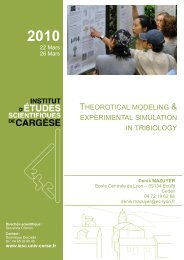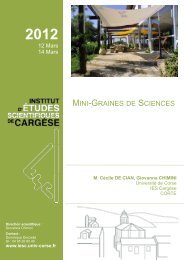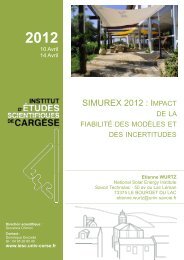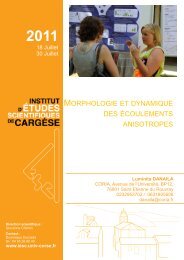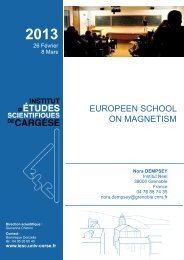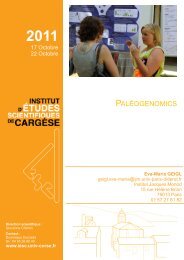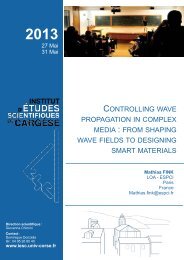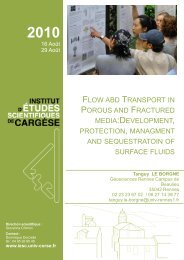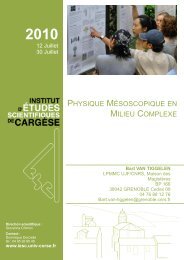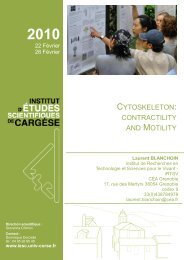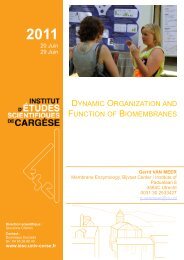nanoelectronics - Institut d'Études Scientifiques de Cargèse (IESC)
nanoelectronics - Institut d'Études Scientifiques de Cargèse (IESC)
nanoelectronics - Institut d'Études Scientifiques de Cargèse (IESC)
Create successful ePaper yourself
Turn your PDF publications into a flip-book with our unique Google optimized e-Paper software.
Posters<br />
Nonclassical photon-pair production in a voltage-biased Josephson junction<br />
Juha Leppäkangas 1 , Göran Johansson 1 , Michael Marthaler 2 , and Mikael Fogelström 1<br />
1<br />
Microtechnology and Nanoscience, MC2, Chalmers University of Technology, SE-412 96<br />
Göteborg, Swe<strong>de</strong>n<br />
2<br />
<strong>Institut</strong> für Theoretische Festkörperphysik and DFG-Center for Functional Nanostructures<br />
(CFN), Karlsruhe <strong>Institut</strong>e of Technology, D-76128 Karlsruhe, Germany<br />
We investigate electromagnetic radiation emitted by a small voltage-biased Josephson<br />
junction connected to a superconducting transmission line. For weak tunneling couplings and<br />
frequencies below the well known emission peak at the Josephson frequency (2eV/h), extra<br />
radiation is triggered by quantum noise in the electromagnetic environment. For typical ohmic<br />
transmission lines, the corresponding photon flux spectrum becomes symmetric around half<br />
the Josephson frequency, indicating that the photons are predominately created in pairs. By<br />
establishing an input-output formalism for the microwave field in the transmission line, we<br />
give further evi<strong>de</strong>nce for this non-classical photon pair production, <strong>de</strong>monstrating that it<br />
violates the classical Cauchy-Schwarz inequality for two-mo<strong>de</strong> flux cross correlations. In<br />
connection to recent experiments [1], we also consi<strong>de</strong>r a stepped transmission line, where<br />
resonances increase the signal-to-noise ratio.<br />
[1] M. Hofheinz, F. Portier, Q. Baudouin, P. Joyez, D. Vion, P. Bertet, P. Roche, and D.<br />
Esteve Bright Si<strong>de</strong> of the Coulomb Blocka<strong>de</strong>, Phys. Rev. Lett. 106 217005 (2011)<br />
__________________________________________________________________________<br />
Gap Generation in Topological Insulator Surface States by non-Ferromagnetic<br />
Magnets<br />
László Oroszlány 1 , Alberto Cortijo 2<br />
1<br />
Department of Physics of Complex Systems, Eotvos University,<br />
H-1117 Budapest, Pázmány Péter sétány 1/A, Hungary<br />
2<br />
<strong>Institut</strong>o <strong>de</strong> Ciencia <strong>de</strong> Materiales <strong>de</strong> Madrid, CSIC, Cantoblanco, 28049 Madrid, Spain.<br />
Within a tight binding approach, it is shown that, contrary to the naive expectation, single<br />
particle spectral gaps can be opened on the surface states of three dimensional topological<br />
insulators by using commensurate out- and in-plane antiferromagnetic or ferromagnetic<br />
insulating thin films [1].<br />
[1] L. Oroszlány, A. Cortijo arXiv:1208.4615<br />
__________________________________________________________________________<br />
Optical conductivity of bilayer graphene in the far-infrared (FIR) spectral range<br />
Gábor Széchenyi, József Cserti<br />
Department of Physics of Complex Systems, Eötvös University, Budapest, Hungary<br />
Using Kubo formula we study theoretically the frequency <strong>de</strong>pen<strong>de</strong>nt optical conductivity in<br />
bilayer graphene with symmetry breaking mechanisms. We <strong>de</strong>monstrate that in the FIR<br />
spectral range (1.2-80 meV) the spectrum is strongly sensitive to the rate of the symmetry<br />
breaking, the trigonal warping and the polarization of the light. We show analytically a<br />
connection between the minimal conductivity and the zero frequency limit of the optical<br />
spectrum.



